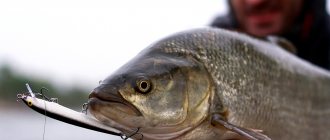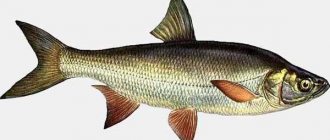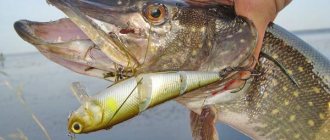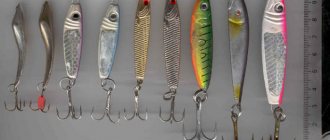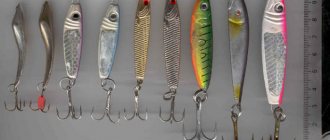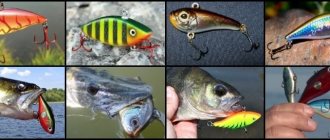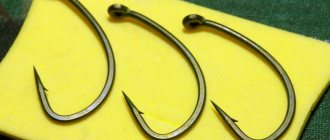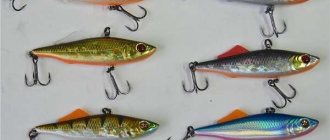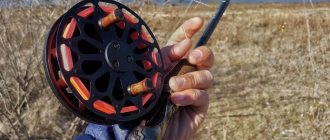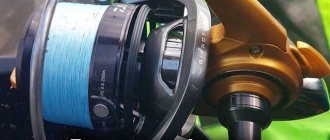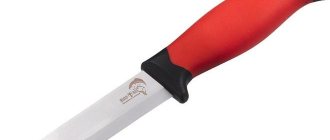Criteria for choosing wobblers for asp
The word "wobbler" comes from the English "wobbler", which has several meanings, among them - eccentric, that is, a person who performs unexpected actions. Another possible translation option is an unpredictable, unreliable personality. In fishing, this term refers to an artificial voluminous bait made of dense material, usually in the shape of a small fish, which is used mainly for hunting predators.
While in the water, the wobbler, under the control of a skilled fisherman, makes chaotic movements reminiscent of the splashing of a fry, which attracts large river inhabitants that attack potential prey and thus get hooked. When choosing a wobbler model for catching asp, it is therefore important for the fisherman to know well the habits of this fish, its traditional hunting grounds, the list of favorite “victims”, as well as many other conditions that will allow an obviously inedible object to be passed off as an appetizing and, at the same time, safe delicacy .
Asp, also known as sheresper, cherry, whiteness or whiteness, is the largest species in the large cyprinid family. The average size of this fish is 40–50 cm with a weight of 1.5 to 2 kg, but adults can grow up to 70–80 cm and gain 6–8 kg of weight. It is important that the sheresper does not acquire the habits of a predator right away: young fish feed on various worms, crustaceans and the remains of plant food - that is, they lead a lifestyle characteristic of all cyprinids.
The asp begins to purposefully hunt for live floating prey, having reached the above-mentioned dimensions of an adult, thus, when selecting a wobbler, one should proceed from the fact that the prey will be quite large. On the other hand, the structure of the mouth and teeth of the asp is not typical for a predator.
Important! Predatory fish have a grasping mouth and jaws with sharp teeth, which allows the fish to capture, hold and swallow large prey. Peaceful representatives of aquatic vertebrates, which generally include cyprinids, have a small mouth and teeth located deep in the larynx, therefore, even leading a carnivorous lifestyle, they can only hunt small fish.
The traditional prey of an adult asp is:
- bleak;
- gudgeon;
- dace;
- bystryanka;
- chub;
- frogs;
- crayfish.
A bait weighing over 200 g, according to the experience of professional fishermen, rarely attracts the attention of even a very large sheresper due to potential difficulties in swallowing prey, even if it is possible to retain it. However, the presence of a special tubercle on the upper jaw and a “corresponding” notch on the lower jaw helps the asp not to let the prey out of its mouth, but still the hunting technique of this fish differs significantly from that used by pike, pike perch or perch.
So, the main tool of a sheresper is swiftness and maneuverability . At great speed, this unusual predator bursts into a school of unwary fish and drowns them out with blows of its massive tail. After such a successful attack, all that remains for the attacking side is to collect the victims who have lost their orientation in space. The fishermen called this technique “battle.” It can be observed from the shore or from a boat, since it reaches its maximum efficiency in the upper layers of water, where the impact of the tail on the surface creates a particularly strong stunning effect.
Did you know? The copyright for the invention of the wobbler was granted to an American beekeeper named James Haddon in 1894. According to one version, he came up with artificial bait by accident, throwing sawdust used in the process of making a hive into the water and watching how predatory perches rushed at inedible objects; according to another, he picked up the idea from local Indians.
But the asp is not always able to detect a whole school of small fish, so the fish has also adapted to hunt single prey, although for this it uses a different method - a lightning-fast throw, sometimes with a cross-movement. It is for this tactic that the use of wobblers is designed. Having understood the basic principles of fish behavior and its taste preferences, you can begin choosing bait.
Range
Like all cyprinids, sheresper is a very cautious fish. Many fishermen even consider hunting for this particular freshwater inhabitant the most difficult from the point of view of the importance of such a criterion as camouflage. One of the main techniques that allows a fisherman to hide the fact of his presence from potential prey is long-distance casting of bait.
Thus, long-range, including high aerodynamic properties, is a mandatory criterion when choosing a wobbler. Of course, the spinning rod must match such bait. For this gear, such an indicator as sending capacity is extremely important. It is better to catch an asp using a fast rod action, or even better - an extrafast one.
Did you know? The exact origin of the Russian name for the fish asp is unknown, but there is an assumption that it was formed from the Old Slavic “zher”, that is, “food”, and denotes the phenomenal appetite of the asp. The verb “to eat”, used in the sense of “eating greedily,” has the same etymology.
Size and weight
The size and weight of the artificial fish, of course, should be as close as possible to the parameters of the prey that the predator hunts. Although experts do not give clear recommendations on this matter, noting some variability in the taste preferences of asp.
The approximate size of the “prey” can be from 5 to 8 cm, but it is better to have several options in stock. As for weight, it is important to understand that a wobbler that is too light will be difficult to throw to the required distance. However, you also cannot overdo it with this parameter, otherwise it will not be possible to ensure the correct play of the bait, because the asp usually hunts in the rifts, slightly away from the strong current, so the wobbler does not need to overcome much water resistance.
Important! It is believed that, for all its unpredictability, the sheresper reacts better to small bait than to large bait.
Body Shape
As you know, wobblers are usually divided into 8 groups according to their shape:
- Minnow - oblong, similar to a small twig, which is why they are sometimes called “sticks”;
Taking into account what kind of fish the asp most often hunts, the optimal form of wobbler for this predator is the Minnow category. It is this kind of bait that is most similar in appearance to bleak, gudgeon or perch. - Shad — flat and tall, imitating fish of the herring family;
- Fat - literally translated as “fat”, having the shape of a fat and lazy fish;
- Crank — tall and flat, designed to work at shallow depths or in strong currents;
- Rattlin — diamond-shaped wobblers filled inside with balls that rattle during the game;
- Poppers — bladeless baits with a recess in the upper part for fishing in shallow water and in heavily overgrown reservoirs, a characteristic feature is the ability to create strong vibration and a squelching effect;
- Jerk Bait — large baits for medium depth, designed for sharp, jumping retrieves;
- Jointed - “composite”, which is a structure of several parts connected to each other using a hinge.
Colors
The asp is a diurnal predator . Its first hunting period begins immediately before sunrise, then the fish rests until about noon, after which it again goes in search of prey, and finally, the third “meal” of the sheresper falls between four and six o’clock in the evening. However, if the day turns out to be cloudy, the asp can peck almost without interruption, although in this case its activity is somewhat lower.
Did you know? The largest freshwater fish ever caught in Russia is catfish: the giant’s body length was 460 cm and it weighed 460 kg. True, the record recorded back in the century before last is unlikely to be broken today, given the critical pollution of the World Ocean.
When choosing the color of a wobbler, it is important to take into account both the time of day and the degree of solar activity, although as a general rule, the bait, of course, should be as similar as possible to the real prey of a predator. Taking into account that asp hunting mostly takes place in the upper layers of water, the wrong color of the bait can be especially critical.
Thus, wobblers of exotic colors are suitable for fish that are very hungry and confident in their own unlimited power, while the sheresper is an intelligent and cautious opponent. Therefore, it is better to stick to the natural color scheme for minnows and bleaks, that is, a gray back and, possibly, a yellowish or pink belly. However, for reservoirs with muddy water, brighter options are also acceptable.
As a hint, novice asp hunters can use the following recommendations for changing the color of the wobbler depending on the time and fishing conditions:
| Specified external conditions | Recommended bait color | Wobbler color coding in the product line from (Finland) |
| It's a nasty day | grey, with minimal reflection | SMU (Silver Mullet); GRM (Grey Mackerel) |
| sunny day | silver, with a pronounced sheen | SB (Silver Blue, silver blue); SSH (Silver Shiner, silver shining); SSD (Silver Shad, silver shaded); TSD (Tennessee Shad, Tennessee shaded). |
| Sunset with red and orange reflections in the sky | sparkling, with the presence of colors in the color of the sky | OPSD (Original Pearl Shad) GRT (Glow Red Tiger) |
Depth of depth
It is necessary to play with an asp using a wobbler where this predator usually hunts. As a rule, these are layers of water close to the surface, sometimes even sandy shallow water (the sheresper especially often comes close to the shore in the spring, when, along with melt water, a lot of different food enters the reservoirs, attracting small fish).
Important! The maximum depth suitable for asp fishing is 1.5 m.
Bait game
The so-called floating wobblers are ideally suited for asp hunting, with which you can use the rafting method - the natural movement of the bait to the predator’s hunting spot and then its playful retrieval in the opposite direction, accompanied by slight trembling and small amplitude oscillations.
However, this option is not the only possible one. Sinking wobblers, as well as baits with neutral buoyancy (suspenders) are also very successfully used for catching asp. Thus, a suspender performs well when fishing at shallow depths in an area heavily overgrown with algae; in this case, you need to throw the bait into a pre-selected “window” between the underwater vegetation, tug it a little and then pull it up and down. Sinking baits are suitable for strong currents, where the slow-moving game of the Minnow with a “stop & go” retrieve (alternating intermittent retrieves and subsequent short stops) will not leave any predator indifferent.
Walkers for asp - Denis Vikhrov - on the Pro Anglers League website.
07/14/201610:2514.07.2016 10:25:50 Hello everyone, friends, last night there was one episode on the river, if it weren’t for him, then I think this entry would not have existed.
First, I’ll tell you about the episode itself, then I’ll write my thoughts, and then I’ll have a question for you, since your experience is very interesting. Yesterday evening, together with Stas Sedletsky, we decided to visit the urban section of the Moscow River, the goal was reconnaissance, we were interested in asp and pike perch. Therefore, we chose, in my opinion, a killer time from 18:30 to 23 hours. We arrived at the river and decided to start with topwaters. I took with me a fairly powerful Graphiteleader Aspro 742M paired with a Daiwa Caldia 3000 reel and Sunline Super PE Nagi Kuogi #1.2 braided line; the choice of gear was dictated by the fishing conditions. The coastal zone is a low parapet, overhanging trees, an area overgrown with grass with a length of 300-500 meters, the grass from the shore extends up to 20 m. You need to cast the bait as far as possible, move it to the grass and throw it. Therefore, poppers and walkers of not the smallest size flew into the water, but rather medium ones, weighing about 10 grams, since the cast had to be made at least 30 meters. The use of a thin cord is excluded, constant contact with the grass and pulling through the grass, plus the opportunity for trophy fish. The first contact occurred with Stas on a megabass walker, literally a meter before the end of the wiring, right on the edge of the grass, a powerful breaker and past. The asp was clearly over one and a half kg. Our attempts to catch it with poppers were unsuccessful. By the way, until the evening there was no rutting of the fry; we fished blindly along this grass. My next contact occurred after an hour of fishing. The asp appeared out of nowhere and quickly hit the walker, devouring him tightly. The stick was loaded, the clutch began to sing, but I was ready, tired the guy and brought him to the parapet. How to take? Asp about 2kg. I tried to lift it by the fishing line, it was risky, but it seemed to hold. I decided to lie down on a small parapet and try to reach it with my hand. Stas was watching everyone nearby all this time. I lifted his head with a cord, and was already beginning to, in fact, stroke him, when the cord simply burst. The asp flopped into the water with the walker and slowly swam away to his home. As it turned out later, the cord was pretty frayed, the last 2 meters, apparently after the last fishing with a diverter leash. It was doubly offensive, I lost a ridiculous trophy, and lost an old working walker from Damiki. For all the remaining time, I managed to catch only 1 perch on a different walker, the work of which is fundamentally different from the one that caught the asp. It didn’t work out with the pike perch, not a single contact, either with minnow or deep minnow wobblers, possibly due to a suitable thunderstorm. It was difficult to find a photo of this walker, and I also found a similar walker in my father’s box, which he immediately confiscated. This is one of the walkers that made me happy in catching any fish. Already at night, returning home, I shook out all the boxes with walkers and realized that I had few workers, there were a number of topwaters that brought success in asp. Such as the Uzhgorod stick, Smith Tovadi, but these walkers are too light and small for these conditions. More solid options are needed. Ever Green Showerblows are also available, but there are no practices or examples for asp; it catches bass, pike, and perch. In general, I have a gap in this type of bait, and I want to close it. There are pike walkers, the whole question is in asp models, I would be very grateful for any of your advice and experience in catching asp with this type of bait. The weight of the bait is at least 10g. I will be glad to any comment. With respect to all readers. pal.sport-express.ru
TOP 10 best wobblers for asp
The concept of “the best wobbler for asp” is a very conditional category, because the catchability of the bait largely depends on the given conditions, time of year, chosen location, weather, fisherman’s skills and, finally, the mood of the fish itself.
Did you know? The success of marketing the products of one of the most famous manufacturers of wobblers - Finnish - is due to an unusual coincidence of circumstances. An advertising article about quality lures appeared in Life magazine with the recently tragically deceased Marilyn Monroe on the cover, it was this circumstance that made the issue the best-selling in the history of the publication.
And yet, based on numerous reviews from professionals, it is possible to make a rating of the best options in your group.
- Kikuchi Bay Fighter Si 70S. Sinking version of Minnow, product length 70 mm, weight 11 g. Provides amazingly realistic game, and has deservedly received rave reviews from almost all anglers who were lucky enough to use the model. The only problem is that it is very difficult to get this product today; time-tested classics, unfortunately, are giving way to newer models. A similar variant in terms of parameters from the same Japanese company - Kikuchi Bay Fighter Si 90S, differing only in its longer length (90 mm), can also be safely placed at the first level of the rating.
- Salmo Thrill 7. Polish version of the sinking Minnow. It has almost the same characteristics as the previous model: 70 mm in length and 12 g of weight. Designed for play in different ranges of working depth - from surface layers of water to full 5 m. The model has been on the market since 2007, and the number of its fans is steadily growing. Indispensable in places where the asp is looking for schools of small fish. It works well in fast, uniform retrieves with acceptable pulling of the bait out of the water (imitation of the cheerful play of fish on the surface), as well as slow movements alternating with jerks and subsequent pauses, during which the bait slowly sinks to the bottom, it is at this moment that the predator usually grabs it attacks. Another advantage of the model is its long casting (up to 70 m), thanks to its fairly large weight for its size. As in the first case, it makes sense to name the closest pair to this wobbler, which should be purchased at the same time and used as an alternative to improve fishing performance. This is a slightly heavier Salmo Thrill 9.
- ZipBaits Rigge 56. Floating Minnow made in Japan. It is slightly smaller in size than the above-mentioned wobblers: the length is only 56 mm, the weight is 2.8 g. It goes deep to 50–100 cm. The main distinguishing feature is the Mag Drive magnetic balancing system, which ensures both casting accuracy at long range and perfectly horizontal location of the bait on the surface of the water. In addition, the wobbler has a special body shape, triangular in cross-section, which provides very good illumination of the bait from all sides. Another advantage is its versatility: the model can be used in still water and in strong currents. The ideal type of animation is twitching (jerk movements), as well as low-amplitude movements with low frequency. In addition to asp, it is effective for catching pike and perch.
- IMA Farina 90 SR. Another sinking “killer” of asps, created by skilled Japanese craftsmen. Length 90 mm, weight 12 g. Working depth from 20 to 80 cm, that is, exactly what you need for asp hunting. The product appeared on the market relatively recently, in 2012, but has already managed to conquer almost the entire world. It is distinguished by a very high range, which is ensured by a tungsten weight, which also allows the bait to play equally flawlessly in almost any conditions.
- Saurus CD-Rex 70. Sinking Minnow, 70 mm long and weighing 9 g. Manufacturer: Japan. A distinctive feature is a huge selection of different colors. The model is not very popular, but it is very popular among professional spinning fishermen and some deeply interested fishermen. Suitable for hunting lightning-fast asp, slow-moving chub, as well as “classic” predators - pike and perch.
- Jackall Brosrry 44 CheF. A floating wobbler, but, unlike previous models, it has a Crank or crankbait shape that is not very standard for asp fishing. Working dimensions 44 mm, weight 6.2 g, maximum depth 80 cm, main color - light green. A compact “rattle” with a very strong acoustic effect and excellent aerodynamics, ensuring long and accurate casting. Thanks to its sweeping and colorful game with a smooth trembling during the retrieve, amplified by a bright sound accompaniment, the model is indispensable where, due to turbid water, a predator may not notice less bright baits.
- Lucky Craft Clutch MR. Another floating crankbait designed for working at medium depths (the designation “MR” in the model stands for “Medium Runner”, i.e. medium runner). Length 42 mm, weight 6 g. Working depth from 50 to 100 cm. Excellent for still water and strong currents, in both cases providing stable high-frequency animation and not allowing a predator to swim past indifferently. Correct loading, good aerodynamic qualities and additional sound effect are created due to the metal ball built into this wobbler.
- Jackson Rogos 65S. A sinking Minnow, not suitable for shallow water, but excellent in deep and medium water. Product length 65 mm, weight 7 g, minimum depth 1.5 m (maximum 2.3 m). Well suited for both twitching and slow measured retrieves.
- Liberty Fatty Minnow 70SP. A wobbler with neutral buoyancy (suspender), has a length of 70 mm, weight 8.2 g. A feature of the shape is its noticeable fatness: although the bait belongs to the Minnow category, this is indicated by the clause “Fatty”, that is, plump. The depth parameters are ideal for asp fishing - from 80 to 140 cm. Among the advantages of the product, fishermen traditionally note good aerodynamic properties, attractive animation, and relatively low cost.
- Smith D-direct 55S. Sinking heavy wobbler of the Minnow type, 55 mm long and weighing 6 g. Designed for fishing at the maximum depth for asp - more than 1 m. Fast diving is ensured by a large and voluminous blade. It also guarantees a characteristic vibration, with smooth swaying and rotation, very reminiscent in appearance of the last convulsions of a dying fish sinking to the bottom - easy prey for any predator. However, having stumbled upon any obstacle, for example, the stem of an underwater plant, the bait, which is not very dense in structure, instantly “comes to life” and begins the game again, at the same time deftly avoiding getting caught or entangled. Interesting features also include the bright hologram coloring and backward curved shape, which together lead to a very attractive shimmer in the front and tail of the wobbler.
Tackle for catching asp and rules for selecting a wobbler
Before you go hunting for asp, you need to choose durable gear that can withstand the weight of the bait and the weight of the prey. The choice depends on many criteria: on the place of fishing in the first place.
When fishing in the thickets, a long spinning rod will only get in the way, so it’s better to pay attention to a short rod, you can choose a seven-foot rod. When there are no obstacles, then you should take a rod 2.5 m long.
You shouldn’t take braided wire, because it’s quite difficult to catch something and pull it out - it breaks very quickly. Therefore, it is worth taking a monofilament line with a diameter of 0.22 mm.
The reel is a 2500 or 3000 FA spinning reel with a friction brake that is well adjusted. Only this will help to hold and hook prey weighing 5-8 kg.
One of the main criteria for choosing a wobbler for asp hunting is the casting range. This fish is very careful and does not allow you to get close to it; if it senses danger, it will immediately swim away.
Range is an important criterion, but not the only one; you need to take into account:
size;- immersion depth;
- bait shape;
- stability of play in the current.
For asp, it is better to take minnow class wobblers, especially floating models. Sometimes, depending on the hunting area, suspenders or sinking baits are suitable. It is important to choose the right diving depth in order to fish exactly those layers of water where the asp is found. A suitable model should not dive deeper than 1.5 m.
If you choose floating models, they have one important advantage: you can use the rafting method for fishing. The principle is that first the wobbler smoothly descends to a given depth, where the wiring is carried out. This tactic is quite effective and guarantees positive results after just a few minutes of play.
The color should be chosen carefully. This predator prefers natural colors, such as its favorite prey - bleak. You should not take bright and non-standard colors, as this may give a completely different result.
It is very important that the bait can play an interesting game, both at a steady speed and during twitching.
When jerking, it should not float to the surface, otherwise you will have to guide such a wobbler only with uniform reeling.
The size of the bait is selected depending on the size of the desired prey and the depth where the fishing is carried out.
If there are only small individuals in the reservoir, then they rarely pay attention to large baits; it is better to get by with medium or small models.
Use large wobblers only when fishing a layer of water above a school of fish.
The shape should be chosen the same as that of the asp’s favorite prey. Although, sometimes this predator is not at all against a bait of a non-standard shape. On the shelves you can find models that realistically resemble wounded prey: with a broken spine or a “pot-bellied” belly. They are also popular and can bring good catch to the fisherman.
The best models of wobblers for asp
The stores have a huge range of models of different shapes, sizes and colors.
The best wobblers for asp:
Lucky Craft Clutch MR. Equipped with special metal balls that serve as a load. They help to play an interesting game with a high vibration frequency. The model is used for fishing in still water, working depth up to 1 m.- Jackall Bros Cherry. It has not only fast and smooth play, with wide fluctuations, but also a noise effect. The best fishing technique is casting. Immersion depth – up to 2 m.
- Lucky Craft Flat CB MR. High quality model with good performance. Typically used for hunting in still water or small currents. Interesting design, fast play, noiselessness and a shifted center of gravity are the main features of this wobbler.
- Imakatsu Crank IK. Plays a wide game and can be used on any type of reservoir. Suitable for both professionals and beginners. With its help you can easily make long casts.
- Salmo Thrill. The model is specially designed for catching asp. Used in reservoirs of any type, it has a sweeping and interesting game. Can dive to a depth of 5 m.
Techniques and tactics for catching asp using wobblers
To successfully catch asp with a wobbler, it is not enough to acquire high-quality bait; you also need to master the technique of handling it. The most effective method of hunting for the cunning sheresper among fishermen is called “waddling”. The main feature of the tactic is the most accurate and long-distance casting, eliminating subsequent repeated attempts that will only scare off the predator. The hunt begins with bait. Crumbs of bread, dust or other delicacies are thrown into the water, which is designed to attract a school of small fish. It is for her that the predator will come.
Important! One of the main conditions for effective asp fishing is high-quality camouflage, a minimum of unnecessary movements and complete silence. As for the technique, as a rule, it involves horizontal wiring almost on the surface of the water.
Having noticed a characteristic splash of water on the surface of the water, the very “fight” of a hunting asp, the fisherman needs to throw the bait exactly into the center of the circle created as a result of the impact from the waves diverging in all directions. Then the rod should be fixed in an almost vertical position and begin to intensively reel in the line until a powerful and decisive attack occurs - first a grip and immediately followed by a strong throw to the side. At this moment, the line must be released, giving the predator an illusory sense of freedom.
